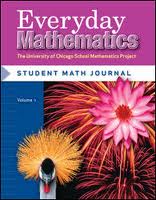RESOURCE ROOM - Mrs. Rullo (Grade 4)
Page Navigation
Math
-
Everday Math Curriculum (see related link below)
Unit 1:
- To introduce students to the Student Reference Book,
- To practice using geometry tools,
- To classify quadrangles,
- To explore and identify polygons, and
- To review and practice addition and subtraction facts.
Unit 2:
- To examine different uses and equivalent names of numbers and review the base-ten place-value system,
- To review procedures for addition and subtraction of multi-digit whole numbers, and
- To reintroduce and extend ideas about data collection, organization, display, and analysis.
Unit 3:
- To review strategies for solving multiplication facts; and to help students work toward instant recall of the multiplication facts,
- To provide practice interpreting data, measuring length, and using a map scale through the World Tour Project,
- To introduce a simplified approach to solving number stories; and to provide practice solving number stories, and
- To provide practice with number sentences and open sentences.
Unit 4:
- To extend the base-ten place-value system to decimals,
- To review and extend basic concepts, notation, and applications for decimals,
- To extend whole-number methods of addition and subtraction to decimals, and
- To review relationships among metric units of length, and guide students as they use them.
Unit 5:
- To extend basic multiplication facts to review the basic principles of multiplication of multi-digit numbers,
- To provide practice estimating and deciding when estimation is appropriate,
- To review and provide practice with the partial-products algorithm
Unit 6:
- To provide practice solving multiplication and division number stories,
- To introduce the division algorithm and the concept of remainders as fractions or decimals,
- To provide practice drawing, measuring, and naming angles using half-circle and full-circle protractors, and
- To introduce latitude and longitude and to utilize letter-number pairs and ordered pairs on a grid system.
Mid-year Assessment: After several math lessons, students are given an assessment based on the lessons taught.
Unit 7:
- To review fractions as parts of a whole (ONE), fractions on number lines, and uses of fractions,
- To guide students as they order fractions and find fractional parts of sets and regions,
- To provide practice identifying equivalent fractions, and
- To review basic ideas of probability, comparing predicted and actual results, and guiding the application of fractions to chance experiments.
Unit 8:
- To review perimeter and area concepts,
- To develop formulas as mathematical models for the areas of rectangles, parallelograms, and triangles, and
- To explore applications of area with scale drawings.
Unit 9:
- To reinforce naming equivalencies among fractions, decimals, and percents,
- To reinforce the use of a data table, guide the organization and tabulation of survey data, and rank and compare data reported as percents, and
- To introduce multiplication and division of decimals by whole numbers.
Unit 10
- To guide the discovery of basic properties of reflections, involving 2-dimensional figures and the connection with line symmetry,
- To guide the application of reflections, rotations, and translations, and
- To introduce addition involving negative integers.
Unit 11:
- To review grams and ounces as units of weight,
- To identify geometric solids, given their properties,
- To review concepts and units of capacity and volume, and
- To introduce subtraction involving positive and negative integers.
Unit 12:
- To introduce rates and provide practice collecting and comparing rate data,
- To provide practice solving rate problems, to provide practice comparing unit prices and identifying information needed for comparison shopping, and
- To reflect on this year’s World Tour experiences and progress on 50-facts tests.
End-of-year Assessment: This is a cumulative assessment of all the math concepts taught from the beginning of the year to the present.


